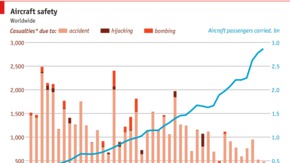እረዳት አብራሪ ሀይለመድህን አበራ ኢትዮጵያ አየር መንገድ ንብት የሆነውን Boeng 767-300 17Feb 214 ዋናው አብራሪ ለእረፍት በዎጣበት ጊዜ ኩክፒት(cock pit) ከዎሥጥ በቆለፍ የበረራውን አቅጣጫ በማሥቀየር በመንገደኞች ላይ ምንአይነት የሥነልቦናም ሆነ የህይዎት ጉዳት ሳያደርሥ አውሮፕላኑን ሲውዘረላንድ ጀኔቭ በሰላም በማሳረፍ ጥገኝነት በመጠየቁ ምራብዊያን ሥለረዳት አብራሪ ሀይለመድህን አበራ ብዙ ብለው ነበር ለምሳሌ የአዕምሮ በሽተኛ ሊሆን ይችላል የሚል ከተሰጦት መሰረተ ቢስ አሥተያየቶች መካከል ይገኝበታል ነገር በተመሳሳይ ከአንድ አመት በሆላ 24March 2015 እረዳት አብራሪ ብሪስ ሮቢን(c0_pilot Brice Robin) ንብትረትነቱ የሉፍታዛ አየር መንገድ (Lufthansa airway) ኤር በስ(airnus )A320 የበረራ ቁጥር(Flight No.) 9252 የሆነውን እረዳት አብራሪ ብሪሲ ሮቢን (Brice Robin)ሆን ብሎ ዝቅ ብሎ ባማብረር አውሮፕላኑ ከአልፕስ (Alps)ተራራ በጋጨቱ በጉዞ ላይ የነበሩት 150 ተጓዥዎች በሙሉ ሞተዋል፣ ፍርድ ለናንተ ዎገኖቸ ማነው የአዕምሮ በሽተኛ?
French investigators say that the co-pilot deliberately brought down a plane in the Alps that killed all 150 on board
| Business and finance
| Business and finance
THE final few minutes on board Germanwings flight 9252 are too horrific to contemplate. The passenger jet operated by Lufthansa’s low-cost subsidiary crashed in the French Alps on March 24th, killing all 150 people on board. The Airbus A320, en route from Barcelona to Düsseldorf, had reached cruising altitude before making a sudden and seemingly inexplicable eight-minute descent that ended in the aircraft colliding with a remote mountainside. The victims, mainly Germans and Spaniards, included a party of 16 schoolchildren and two babies. Two days later, after recovering one of the plane’s “black boxes” that made a recording in the cockpit, French accident investigators made the awful discovery that the plane had been deliberately crashed by the co-pilot.
Brice Robin, the Marseilles prosecutor investigating the crash, said that Andreas Lubitz, a 28-year-old German, had taken control of the plane and locked the pilot out of the plane’s cockpit after he momentarily stepped outside. Voice recordings revealed that the pilot then made increasingly frantic attempts to get back into the cockpit during the plane’s descent. The desperate cries of the passengers, who had become aware of the danger, could be heard in the final moments before the plane came down. Though the co-pilot said nothing during the plane’s final moments his breathing—described as “normal” —could be heard until the end, indicating that he was well aware of what he was doing.
Mr Robin added that although the descent was reasonably controlled it had not been necessary. Still, he said, there was “no element that indicates that this is a terrorist action”. The prosecutor went on to say that he could not call the co-pilot’s actions suicide, but that it was a “legitimate question to ask”. Mr Lubitz’s state of mind and motivations will come under intense scrutiny in the days to come. And questions will undoubtedly be asked about whether airlines do enough to monitor the mental state of their most trusted employees.
Brice Robin, the Marseilles prosecutor investigating the crash, said that Andreas Lubitz, a 28-year-old German, had taken control of the plane and locked the pilot out of the plane’s cockpit after he momentarily stepped outside. Voice recordings revealed that the pilot then made increasingly frantic attempts to get back into the cockpit during the plane’s descent. The desperate cries of the passengers, who had become aware of the danger, could be heard in the final moments before the plane came down. Though the co-pilot said nothing during the plane’s final moments his breathing—described as “normal” —could be heard until the end, indicating that he was well aware of what he was doing.
Mr Robin added that although the descent was reasonably controlled it had not been necessary. Still, he said, there was “no element that indicates that this is a terrorist action”. The prosecutor went on to say that he could not call the co-pilot’s actions suicide, but that it was a “legitimate question to ask”. Mr Lubitz’s state of mind and motivations will come under intense scrutiny in the days to come. And questions will undoubtedly be asked about whether airlines do enough to monitor the mental state of their most trusted employees.
The wisdom of using impregnable locks on cockpit doors will also doubtless come under review. Measures to strengthen the barrier between pilots and passengers were introduced in the aftermath of the 9/11 hijackings. Lufthansa explained that although cockpit doors on its A320s can be opened using an emergency override code, this can be rejected repeatedly from the inside. This leaves passengers vulnerable to a pilot intent on crashing his plane. Indeed, this tragedy is alarmingly similar to the one that befell Mozambique Airlines Flight TM470 in 2013, which resulted in the deaths of 33 people. Other crashes have also been blamed on deliberate actions by a pilot after a colleague had left the cockpit, including an Egypt Air flight in 1999 that killed 217, a Silk Air plane that crashed in Indonesia in 1997, killing 104, and LAM Flight 470 that came down en route between Maputo and Luanda in 2013 resulting in 33 fatalities. One of the many theories surrounding the disappearance of Malaysia Airlines flight MH370 also suggests deliberate pilot action. Whether it is safer to return to unlocked cockpits and increase the risk of hijackings is far from clear. Although of little consolation to the victims' families, thankfully both types of disaster are rare.

No comments:
Post a Comment